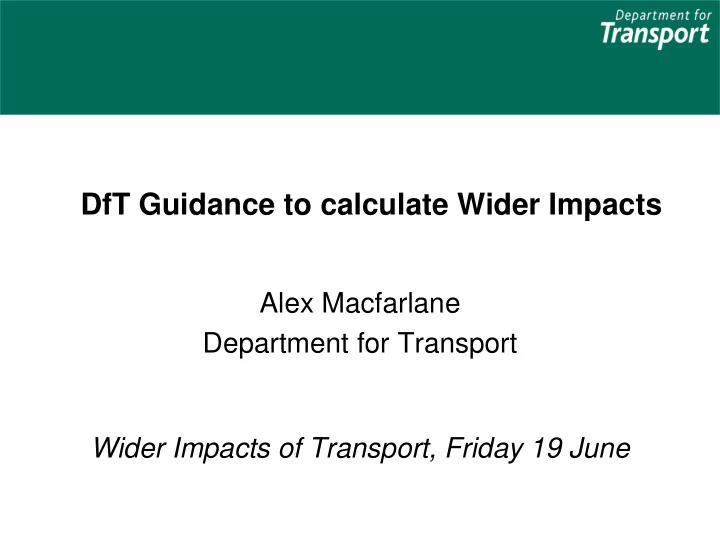

DfT Guidance to calculate Wider Impacts Alex Macfarlane Department for Transport Wider Impacts of Transport, Friday 19 June
History: Wider Impacts and Transport Appraisal • 1999 SACTRA – Transport & the Economy Imperfect competition in transport and transport user markets • 2005 DfT WEBs Paper Optional – used in some major schemes • 2006 Eddington Report Importance of WEBs paper • 2009 Wider Impacts Guidance For consultation
Wider Impacts: what are they? 1. Agglomeration – cities are more productive Sharing – public goods Learning – spill-over benefits Matching – labour and product markets 2. Output changes in imperfectly competitive markets 3. Labour market effects • Transport affects overall labour supply • Transport can change composition of the labour market
What does an assessment of wider impacts involve?
How much do wider impacts matter? Additions to conventionally measured benefits Agglomeration Imperfect Labour Sum additional Competition market benefits Rail Crossrail 19% 3% 22% 44% Road Leeds to Bradford Improved 21% 4% 21% 37% Highways Road Leeds Urban Area Improved 22% 4% 7% 33% Highways PT Leeds to Bradford PT 15% 2% 4% 21% Improvements Bus Intra Leeds bus subsidy 11% 2% 6% 19% Road Leeds to Sheffield Improved 19% 5% -6% 17% Highway Road M6 Shoulder 12% 5% 0% 17% Bus West Yorkshire County bus 9% 2% 6% 17% subsidy PT Leeds Urban Area Major PT 9% 3% 6% 17% investment Bus South & West Yorkshire Bus 7% 2% 5% 17% subsidy - Average 13% 3% 5% 22%
Where does agglomeration matter? Functional Urban Regions • Calculate agglomeration impacts if in or linking a Functional Urban Region: • Core (high job density) • Commuting field • Impacts may not be high for all schemes covering a blue area • You can calculate agglomeration benefits outside of FURs
When to calculate wider impacts • If cost >£20m calculate: – Labour supply effect; and – Imperfect competition And • If in a FUR – Agglomeration impacts WIs will be required for all schemes which satisfy these conditions from April 2010
What’s in it for regions and scheme promoters? • Collectively we all prioritise better transport schemes by including import impacts we previously missed • It could help secure more public investment in transport in general (investment in transport compares favourably to spending elsewhere across government, wider impacts could add to that) • In particular it could help prioritise and secure resources for urban schemes. Flip side is it could de-prioritise some rural schemes.
What’s DfT doing next? • 2 WEBTAG units for consultation – 2.8 (project managers) and 3.5.14 (practitioners guidance) • In draft guidance to be issued by end year • Becomes mandatory guidance in April 2010 • Economic data set to be released shortly • Software to calculate WIs from WEBTAG compliant transport model has been written • To be issued with draft guidance in Dec • Testing software is now underway • Contact WiderImpacts@dft.gsi.gov.uk
Issues for discussion • Does the theory add up? • What evidence would be helpful for those using the guidance? • Are the demands on modellers manageable? • Are the conditions under which Wider Impacts should be calculated unambiguous? • Is the treatment of other associated impacts – congestion, carbon etc - consistent?
Recommend
More recommend